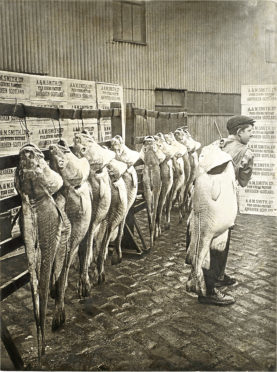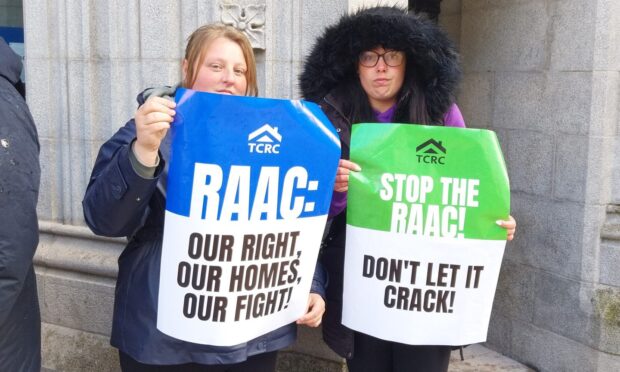A rare photograph of giant cod landed at Aberdeen in 1908 could net £3,000 at auction next month.
The 110-year-old image was taken at Albert Quay on the premises of Aberdonian fish processing and curing firm A. & M. Smith Ltd.
It shows fish many times bigger than those caught today.
The cod, which were destined for export to Spain, weighed an average 77lb (5.5stones) or 35 kilos compared with today’s 5-12kg cod.
One of the largest is slung over the back of a young fish worker while ten more hang on rail hooks in front of well-scrubbed cobbles.
The carbon print photograph, measuring 71.5 x 49.5cm, will be sold at Bonhams in London on March 21, when it is estimated to land £2,000-3,000.
Luke Batterham, Bonhams’ specialist, said yesterday [FRI]: “This striking photograph was…probably intended for display by a Spanish importer.
“It would have made an awful lot of fish suppers.
“It looks like they’ve called in the biggest working boy to hold the fish — he looks rather nonchalant as if he has just slung it over his shoulder, but I’m sure his legs were shaking by the end after being told to keep still for the photograph.”
Mr Batterham said the image, taken in March 1908 by the Aberdeen studio of MacMahon, was not only unusually large but also had socio-historical significance.
He said: “It is visually stunning but it also encapsulates all sorts of interesting changes that have taken place in the past century, such as the decline of the fishing industry, the ecological state of the seas and the employment of children in fish stalls, lugging heavy fish.”
Linda Fitzpatrick, curator at the Scottish Fisheries Museum in Anstruther, Fife, said: “The story of fishing has changed dramatically since this photograph was taken, and images like this can bring that story home to people.
“Aberdeen became a huge area for trawling from the 1880s when the steam trawlers came in and it really took off, and there was a booming market for them at that time.
“Although fishermen are always interested in showing off the cream of the crop, even in those days these giant cod would have been exceptional in size.”
The heaviest cod ever recorded weighed just under 100kg. Their average size at maturity is around 100 cm, with weights in the 5-12 kg range. Older specimens can measure as much as 200cm.










